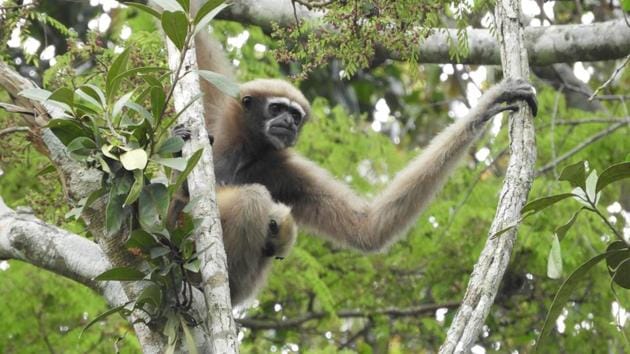Meghalaya’s community-managed forests protect endangered Western Hoolock Gibbon
Over the last three years, the people of Hima Malai Sohmat are working proactively to conserve the Western Hoolock gibbons and in the process, they are saving their forests too.
The Western Hoolock Gibbon, the only wild ape found in India and also among the most endangered primates in the world, has found a safe haven thanks to the people of Meghalaya.

It is estimated that only about 3,000 Western Hoolock gibbons are left in northeast India today. These gibbons are listed among the 25 most endangered primates in the world. The species is classified as endangered by the International Union for Conservation of Nature (IUCN) and as a schedule 1 species by the Wildlife Protection Act, 1972.
Over the last three years, the people of Hima Malai Sohmat are working proactively to conserve the gibbons and in the process, they are saving their forests too.
“Our forefathers believed that as long as you can hear gibbons calling, we are still within the boundary of Hima Malai Sohmat. This is true even today to a certain extent,” says Tyngshain Dewkhaid, from Phlangwanbroi village in the East Khasi hills of Meghalaya.
The village of the 42-year-old school teacher along with four others forms the ancient kingdom of Hima Malai Sohmat. The villages are located close to the world’s wettest region Cherrapunji and the forests that adjoin them is also one of the last vestiges of the Western Hoolock Gibbon, a fast-disappearing ape that has witnessed a 90% decline in its population in the last four decades.
“When we realised that gibbons are found only in a few regions in the world, including our forests, we decided to protect them. Since gibbons live in the forest, we realised that we need to conserve the forests too for gibbon conservation to succeed,” Dewkhaid says.
While the survey to determine the number of gibbons in the Hima Malai Sohmat is under process, conservationists feel the villagers’ efforts are reaping rich rewards.
“We see the Hima Malai Sohmat as a group of villages that can really spearhead a movement that can massively enhance the chances of gibbons surviving in the region,” Divya Vasudev of the Wildlife Conservation Society (WCS) said while speaking to the Hindustan Times.
WCS, an international conservation organisation, is assisting Meghalaya’s villagers and the forest department in gibbon conservation.
“A large proportion of land here is community owned and they have decided to not encroach on the forests. They are also running awareness campaigns for villagers, informing them that hunting gibbons is illegal,” Vasudev adds.
The Western Hoolock gibbon is found in all the northeastern states as well as in parts of Bangladesh and Myanmar. A species that requires contiguous, wet, closed-canopy forests for its survival, it is among the major casualty of deforestation for agriculture, tea estates and other commercial plantations.
“The need of the hour is to check the habitat loss and further fragmentation of their habitats and start at war footing the restoration of their habitats,” Narayan Sharma, an assistant professor in the department of environmental biology and wildlife sciences at the Guwahati’s Cotton University, says.
Sharma has been studying gibbons for the past 16 years.
“Community participation is a must for the conservation of Hoolock gibbons. I have also found that local communities don’t hunt gibbons, citing their ‘human-like families’ and resemblance to humans as well as their harmless nature. Having said that, what we need is sustained conservation efforts to make sure that gibbons survive for a long time in northeast India,” Sharma adds.
Gibbons form monogamous pairs that remain together for years. They are also famous for their emotive calls that echo across long distances in the forests and is used by individuals to attract mates.
The next step for the community is to monetise on their conservation through sustainable eco-tourism.
“A master plan committee has been constituted in our region to balance the needs of tourism with gibbon conservation work. This will help to maintain a green environment in the area, and mass tourism is not a priority for us,” Phlangwanbroi village’s Dewkhaid says.
As part of their eco-tourism, a few homestays have been set up and later this year, the villagers will also be organising guided gibbon tours inside the forests. For now, creating a safe haven for the gibbon is the priority.
“Such initiatives taken by local communities have ramifications not only for their lands but for the country as a whole. I believe such steps could turn the fate of gibbons from a species that is facing a steady decline in numbers, to becoming stable,” Vasudev says.
Get Current Updates on India News, Eid-ul-Fitr Live, Lok Sabha Election 2024 Live, Election 2024 along with Latest News and Top Headlines from India and around the world.



